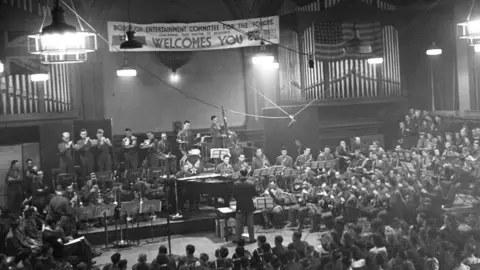What happened to Glenn Miller? The 80-year mystery
 PA Media
PA MediaOn 15 December 1944, the hugely popular musician Major Glenn Miller boarded a small plane at an RAF base in Bedfordshire. The American army band leader was heading to Paris to cheer on the Allied forces, but never arrived. The Norseman aircraft has not been found, but 80 years of theories and investigations have significantly narrowed down the possibilities.
Music for the troops
Glenn Miller was a trombone player, conductor and composer who became famous during the 1930s and '40s with his swing orchestra.
Their big band hits such as In The Mood and Chattanooga Choo Choo dominated the airwaves during World War Two.
In 1942, after the US was drawn into the war, Miller became a US Army Air Force captain and the leader of an army band, helping to bolster morale among the troops.
 Glenn Miller Collections/University of Colorado Boulder
Glenn Miller Collections/University of Colorado BoulderA narrow escape
In June 1944 he was sent to London, tasked with providing broadcast entertainment to the D-Day forces as they took back territory in Europe.
But Bedford tour guide David Fowler said Glenn Miller and his orchestra "wanted a way out" of the capital.
"In June the V1s were coming down, there were bomb raids. The band had never been subject to any war, and they were not happy.
"The BBC had been operating in Bedford since the beginning of the war, so it was an obvious place to come," said Mr Fowler.
Actor David Niven helped the band move to Bedford on Sunday, 2 July, which proved to be a close call.
"On Monday evening, a V1 hit the London billet in Chelsea where the band had been staying - 74 American military were killed in that building," Mr Fowler said.

 Glenn Miller Collections/University of Colorado Boulder
Glenn Miller Collections/University of Colorado BoulderFlight to France
Glenn Miller's band spent five months in Bedford, based at Milton Ernest Hall, delighting troops at military bases, performing for BBC broadcasts and recording with the likes of Bing Crosby and Bob Hope.
But the American musicians were eager to cross to France after the Allies liberated Paris.
"It was always going to be a temporary stopover in the UK. He wanted to follow the Allies' advance as they went into Germany," explained Mr Fowler.
Miller was asked to travel ahead of the rest of his orchestra to complete arrangements. He was booked to fly by scheduled military transport to Paris on Thursday, 14 December, but bad weather saw the flight cancelled.
A US Air Force colleague, Lt Col Norman Baessell, offered Miller a trip on his own flight the following day.
"There were only three of them on the plane – a single-engine Noorduyn C-64 Norseman, piloted by another American," said Mr Fowler.
The flight departed RAF Twinwood for Villacoublay Aerodrome at 13:55 BST on Friday, 15 December after being delayed by mist and fog.
 PA Media
PA MediaGone without a trace
"Military observers charted the aircraft south from England over Beachy Head between 14:30 and 14:45. But it did not appear over France," said Dennis Spragg, who has written a biography on Glenn Miller.
His band arrived in Paris on 18 December expecting to meet their leader. Confused, they contacted the military authorities, who had not been informed of his travel plans.
"He was in violation of his actual travel orders. However, under pressure to meet a deadline, he had sought to perform his duties as he saw fit," said Mr Spragg.
"The gravity of the Glenn Miller disappearance caused shockwaves from London to Washington," he added.
No trace of the Norseman nor the men on board has ever been found.
Various theories have sprung up to explain Miller's disappearance, although most agreed the plane had gone down over the English Channel.
Was it shot down by enemy bombers, or the victim of friendly fire? Had it accidentally been hit by bombs discharged from Allied aircraft?
Others claimed Miller had made it to Paris and was at the Allies' HQ when a German group attacked, or he died in a brothel in the French capital.
 David Fowler
David Fowler'An avoidable tragedy'
An inquiry held in 1945 in Bedford by the Eighth Air Force concluded the C-64 disappeared over the English Channel due to "pilot error, mechanical malfunction and poor weather", said Mr Spragg.
Eight decades on, he believes "there is no mystery" any longer, as more information has emerged.
He said "we know beyond any doubt" that the plane "vanished over water" and that "RAF Lancasters did not accidentally cause the C-64 to crash from an errant bomb jettison".
"The probable causes included icing conditions in the engine, fuel line and on the wings, including carburettor heater failure or possibly a hydraulic fluid leak," said Mr Spragg.
TV programme The History Detectives also investigated the case and compared subsequent Norseman aircraft crashes.
"The documentary came to the conclusion that a single carburettor in cold weather was subject to freezing up. It was a very cold day on 15 December. It's pretty straightforward that a single engine plane could have easily frozen up," said Mr Fowler.

Mr Spragg said Glenn Miller's music was "the anthem of the greatest generation".
"The loss of Maj Glenn Miller on December 15, 1944, was an avoidable tragedy.
"The only remaining question is the location of any debris that might still be found in the English Channel."
Follow Beds, Herts and Bucks news on BBC Sounds, Facebook, Instagram and X.
